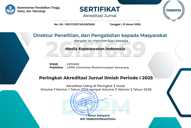Anosmia and Ageusia in Adult Patient with Covid-19
(1) Program Studi Sarjana Keperawatan, Fakultas Ilmu Keperawatan, Universitas Muhammadiyah Jakarta
(2) Program Studi Sarjana Keperawatan, Fakultas Ilmu Keperawatan, Universitas Muhammadiyah Jakarta
(3) Program Studi Profesi Pendidikan Ners, Fakultas Ilmu Keperawatan, Universitas Muhammadiyah Jakarta
(4) Program Studi Sarjana Keperawatan, Fakultas Ilmu Keperawatan, Universitas Muhammadiyah Jakarta
(*) Corresponding Author
Abstract
Early detection of COVID-19 disease in the community is essential, one of the ways is by identifying the symptoms of anosmia (loss of sense of smell) and ageusia (loss of sense of taste). However, it is not yet known how the characteristics of these symptoms can be used as a protocol to prevent the spread of the SARS-CoV-2 virus. This study aims to obtain an overview of the prevalence and characteristics of anosmia and ageusia in adult patients with COVID-19 in the community setting. Descriptive research with a retrospective approach was used to collect outpatients’ data at Puskesmas Kecamatan Cempaka Putih from May – June 2021. A total of 105 participants from 400 patients were selected using a simple random sampling with inclusion criteria were patients who confirmed positive for COVID-19 based on the results of the PCR Swab and had symptoms of anosmia and ageusia. Demographic data and general symptoms of COVID-19 were obtained from the Epidemiological Investigation of Suspected COVID-19 form from the Ministry of Health recorded in medical records, Data on prevalence and characteristics of anosmia and age were obtained through a questionnaire consisting of 12 questions made in google form format and distributed via WhatsApp to the participant. Descriptive analysis showed that from a total of 105 patients in the community with anosmia and ageusia, 103 patients (98.1%) reported anosmia, 50 patients (47.6%) had ageusia, and 48 patients (45.7%) experienced both symptoms. Patients experienced anosmia before being diagnosed with COVID-19 (62, 60.2%) and ageusia after being diagnosed with COVID-19 (28, 56.0%). The median duration of anosmia in days (IQR) was 7 (2) and ageusia was 5 (4). Anosmia and ageusia are symptoms experienced by an adult patient with COVID-19 in the community setting. These two symptoms need to be recognised as typical symptoms of COVID-19, added to the early detection of COVID-19, and included in the self-isolation protocol. Further research on the impact of anosmia and age on health and long-term decline in sensory function after COVID-19 needs to be done.
Keywords
Full Text:
PDFReferences
Grant MC, Geoghegan L, Arbyn M, Mohammed Z, McGuinness L, Clarke EL, et al. The prevalence of symptoms in 24,410 adults infected by the novel coronavirus (SARS-CoV-2; COVID-19): A systematic review and meta-analysis of 148 studies from 9 countries. PLoS One. 2020;15(6):e0234765.
Lovato A, de Filippis C. Clinical Presentation of COVID-19: A Systematic Review Focusing on Upper Airway Symptoms. Ear, Nose & Throat Journal. 2020;99(9):569-76.
Chen X, Laurent S, Onur OA, Kleineberg NN, Fink GR, Schweitzer F, et al. A systematic review of neurological symptoms and complications of COVID-19. Journal of Neurology. 2021;268(2):392-402.
Mao L, Jin H, Wang M, Hu Y, Chen S, He Q, et al. Neurologic manifestations of hospitalized patients with coronavirus disease 2019 in Wuhan, China. JAMA neurology. 2020;77(6):683-90.
Poerbonegoro NL, Reksodiputro MH, Sari DP, Mufida T, Rahman MA, Reksodiputro LA, et al. Cross-sectional study on the proportion of smell and taste disturbances in hospitalized COVID-19 patients. Annals of Medicine Surgery. 2021;71:102909.
Patel A, Charani E, Ariyanayagam D, Abdulaal A, Denny S, Mughal N, et al. New-onset anosmia and ageusia in adult patients diagnosed with SARS-CoV-2 infection. Clinical Microbiology Infection. 2020;26(9):1236-41.
Kaye R, Chang CD, Kazahaya K, Brereton J, Denneny III JC. COVID-19 anosmia reporting tool: initial findings. Otolaryngology–Head Neck Surgery. 2020;163(1):132-4.
Xydakis MS, Dehgani-Mobaraki P, Holbrook EH, Geisthoff UW, Bauer C, Hautefort C, et al. Smell and taste dysfunction in patients with COVID-19. The Lancet Infectious Diseases. 2020;20(9):1015-6.
BAPPENAS RI. Studi pembelajaran penanganan COVID-19 di Indonesia. DKI Jakarta: Kementerian Perencanaan Pembangunan Nasional / Badan Perencanaan Pembangunan Nasional (Bappenas); 2021.
Kementrian Kesehatan RI. Pedoman pencegahan dan pengendalian Coronavirus disease (COVID 19) revisi ke-5. DKI Jakarta: Kementrian Kesehatan RI,; 2020.
World Health Organization. Transmisi SARS-CoV-2: Implikasi terhadap kewaspadaan pencegahan infeksi. 2020. Contract No.: WHO/2019-nCoV/Sci_Brief/Transmission_modes/2020.3.
!!! INVALID CITATION !!! (4, 5, 12).
Cortis D. On determining the age distribution of COVID-19 pandemic. Frontiers in public health. 2020;8:1-3.
Badan Pusat Statistik. Jumlah penduduk menurut kelompok umur dan jenis kelamin, 2021: Badan Pusat Statistik,; 2022 [Available from: https://www.bps.go.id/indikator/indikator/view_data_pub/0000/api_pub/YW40a21pdTU1cnJxOGt6dm43ZEdoZz09/da_03/1.
Alon T, Doepke M, Olmstead-Rumsey J, Tertilt M. The impact of COVID-19 on gender equality. National Bureau of economic research; 2020.
Biswas R. Are men more vulnerable to covid-19 as compared to women. Biomedical Journal of Scientific and Technical Research. 2020;27(2):20645-6.
Jin J-M, Bai P, He W, Wu F, Liu X-F, Han D-M, et al. Gender Differences in Patients With COVID-19: Focus on Severity and Mortality. Frontiers in Public Health. 2020;8.
Gebhard C, Regitz-Zagrosek V, Neuhauser HK, Morgan R, Klein SL. Impact of sex and gender on COVID-19 outcomes in Europe. Biology of Sex Differences. 2020;11(1):29.
Walter LA, McGregor AJ. Sex- and gender-specific observations and implications for COVID-19. West J Emerg Med. 2020;21(3):507-9.
Doty RL. Sensory Aging: Chemical Senses. In: Squire LR, editor. Encyclopedia of Neuroscience. Oxford: Academic Press; 2009. p. 627-34.
Lechien JR, Chiesa-Estomba CM, De Siati DR, Horoi M, Le Bon SD, Rodriguez A, et al. Olfactory and gustatory dysfunctions as a clinical presentation of mild-to-moderate forms of the coronavirus disease (COVID-19): a multicenter European study. European Archives of Oto-Rhino-Laryngology. 2020;277(8):2251-61.
Article Metrics
Abstract view : 647 timesPDF - 13 times
DOI: https://doi.org/10.26714/mki.5.3.2022.216-221
Refbacks
- There are currently no refbacks.
Copyright (c) 2022 Puji Wulandari, Giri Widakdo, Slametiningsih Slametiningsih, Melati Fajarini

This work is licensed under a Creative Commons Attribution 4.0 International License.
This journal is indexed by:
Kedungmundu Raya No. 18 Semarang NRC Building Universitas Muhammadiyah Semarang
Phone: 02476740287
Fax: 02476740287
Email: mki@unimus.ac.id





















